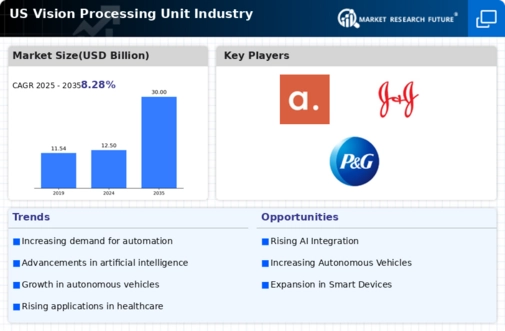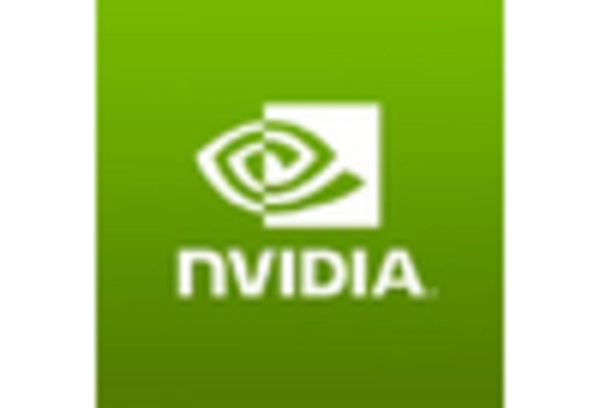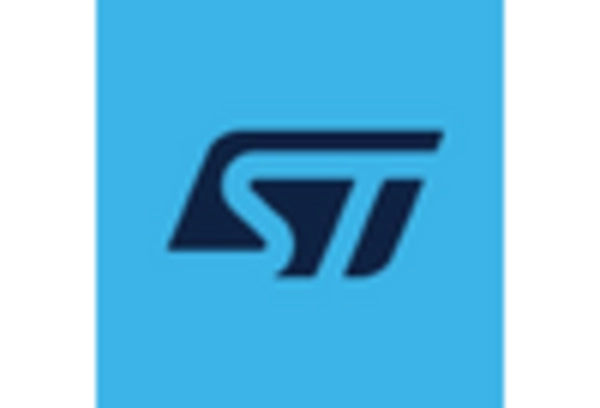Surge in Demand for Smart Devices
The vision processing-unit market is witnessing a surge in demand for smart devices, which are increasingly incorporating advanced imaging capabilities. As consumers seek enhanced functionalities in smartphones, tablets, and smart home devices, manufacturers are integrating vision processing units to improve features such as facial recognition and augmented reality. The smart device market is projected to grow by 20% annually, with vision processing units being a key component in delivering these advanced features. This trend indicates a significant opportunity for the vision processing-unit market, as the proliferation of smart devices continues to reshape consumer expectations and drive innovation within the industry.
Growing Demand for Autonomous Systems
The vision processing-unit market is significantly influenced by the growing demand for autonomous systems, particularly in the automotive sector. As manufacturers strive to develop self-driving vehicles, the need for sophisticated vision processing units becomes paramount. These units facilitate real-time image processing, enabling vehicles to interpret their surroundings accurately. The market for autonomous vehicles is expected to reach $500 billion by 2030, with vision processing units playing a critical role in this transformation. Furthermore, the integration of these units in drones and robotics is also on the rise, as they enhance navigation and obstacle avoidance capabilities. This trend suggests a promising future for the vision processing-unit market, driven by the increasing reliance on automation in various industries.
Technological Advancements in Imaging
The vision processing-unit market is experiencing a surge due to rapid technological advancements in imaging technologies. Innovations in sensor design, such as higher resolution and improved sensitivity, are driving demand for vision processing units. These advancements enable applications in various sectors, including automotive, healthcare, and security. For instance, the integration of high-definition cameras with advanced vision processing units enhances object detection and recognition capabilities. The market is projected to grow at a CAGR of approximately 15% from 2025 to 2030, indicating a robust expansion in the industry. As imaging technology continues to evolve, the vision processing-unit market is likely to benefit from increased adoption across diverse applications, further solidifying its position in the technology landscape.
Regulatory Support for Advanced Technologies
The vision processing-unit market is positively impacted by regulatory support for advanced technologies, particularly in sectors such as automotive and healthcare. Government initiatives aimed at promoting innovation and safety standards are encouraging the adoption of vision processing units in various applications. For example, regulations mandating advanced driver-assistance systems (ADAS) in vehicles are driving the integration of vision processing units to enhance safety features. This regulatory environment is expected to foster growth in the vision processing-unit market, as compliance with safety standards necessitates the incorporation of advanced imaging technologies. The market is likely to expand as more industries recognize the benefits of these technologies, supported by favorable government policies.
Increased Investment in Research and Development
The vision processing-unit market is benefiting from increased investment in research and development (R&D) by key industry players. Companies are allocating substantial resources to innovate and enhance the capabilities of vision processing units, focusing on improving processing speed, energy efficiency, and integration with artificial intelligence. This trend is evident as major tech firms invest billions in R&D to stay competitive in the rapidly evolving landscape. The vision processing-unit market is expected to see a compound annual growth rate (CAGR) of around 12% over the next five years, driven by these investments. As R&D efforts continue to yield breakthroughs, the industry is likely to experience accelerated growth and diversification of applications.
















Leave a Comment